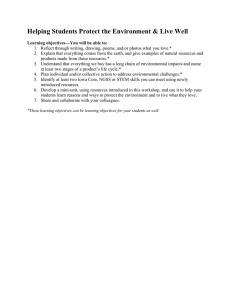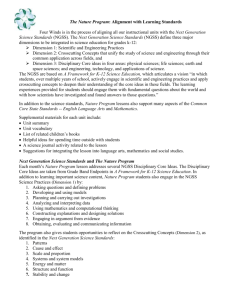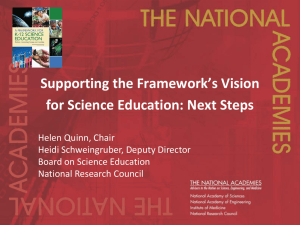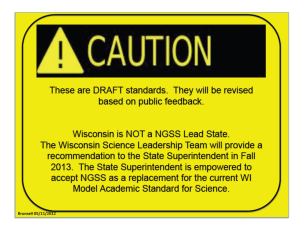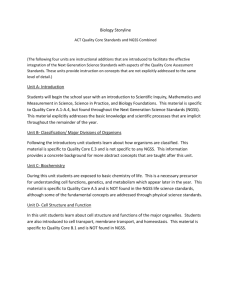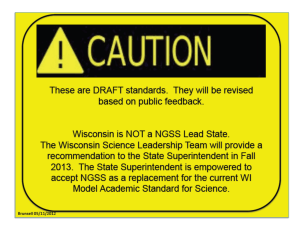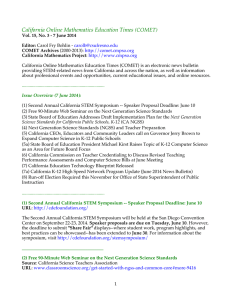REPORT BRIEF Science Teachers’ Learning IN
advertisement
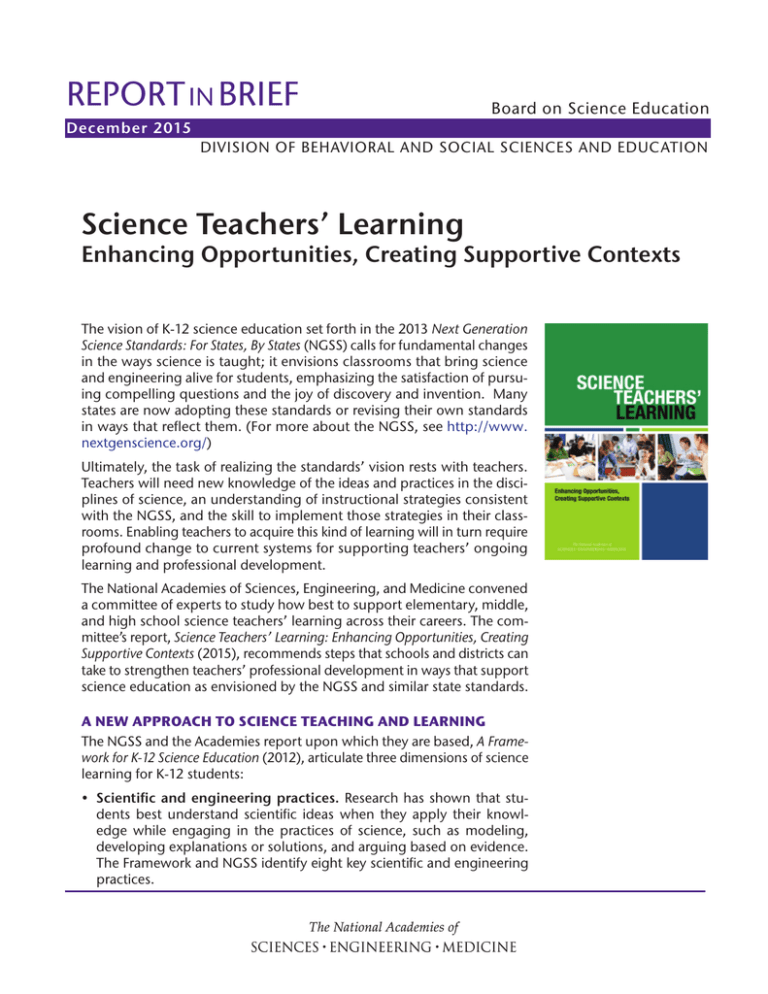
REPORT IN BRIEF Board on Science Education December 2015 DIVISION OF BEHAVIORAL AND SOCIAL SCIENCES AND EDUCATION Science Teachers’ Learning Enhancing Opportunities, Creating Supportive Contexts The vision of K-12 science education set forth in the 2013 Next Generation Science Standards: For States, By States (NGSS) calls for fundamental changes in the ways science is taught; it envisions classrooms that bring science and engineering alive for students, emphasizing the satisfaction of pursuing compelling questions and the joy of discovery and invention. Many states are now adopting these standards or revising their own standards in ways that reflect them. (For more about the NGSS, see http://www. nextgenscience.org/) Ultimately, the task of realizing the standards’ vision rests with teachers. Teachers will need new knowledge of the ideas and practices in the disciplines of science, an understanding of instructional strategies consistent with the NGSS, and the skill to implement those strategies in their classrooms. Enabling teachers to acquire this kind of learning will in turn require profound change to current systems for supporting teachers’ ongoing learning and professional development. The National Academies of Sciences, Engineering, and Medicine convened a committee of experts to study how best to support elementary, middle, and high school science teachers’ learning across their careers. The committee’s report, Science Teachers’ Learning: Enhancing Opportunities, Creating Supportive Contexts (2015), recommends steps that schools and districts can take to strengthen teachers’ professional development in ways that support science education as envisioned by the NGSS and similar state standards. A NEW APPROACH TO SCIENCE TEACHING AND LEARNING The NGSS and the Academies report upon which they are based, A Framework for K-12 Science Education (2012), articulate three dimensions of science learning for K-12 students: • Scientific and engineering practices. Research has shown that students best understand scientific ideas when they apply their knowledge while engaging in the practices of science, such as modeling, developing explanations or solutions, and arguing based on evidence. The Framework and NGSS identify eight key scientific and engineering practices. of low-income students, where teachers are often newer and less qualified. • Crosscutting concepts. The Framework and NGSS also identify seven concepts that show the interconnectedness of ideas across disciplines. For example, the concept of “cause and effect” could be discussed in the context of plant growth in a biology class or in the context of the motion of objects in a physics class. In addition, the U.S. educational system lacks a coherent and well-articulated system of learning opportunities for teachers to continue developing expertise while in the classroom. Opportunities are unevenly distributed across schools, districts, and regions, with little attention to sequencing or how to support teachers’ learning systematically. Typically, the selection of and participation in professional learning opportunities is up to individual teachers, and there is often little attention paid to developing collective capacity for science teaching at the building and district levels. • Disciplinary core ideas. The Framework and NGSS identify core ideas in four major areas: physical sciences; life sciences; earth and space sciences; and engineering, technology, and the applications of science. Under the Framework and NGSS, these three dimensions are integrated with one another in both teaching and learning. Students’ learning experiences in the three dimensions are designed to help them build and revise their understanding progressively, over time and grade levels. Closing the gap between the new way of teaching and current instruction in many schools will require attending to individual teachers’ learning needs, as well as to the larger system of practices and policies—such as allocation of resources, use of time, and provision of opportunities for collaboration— that shape how science is taught. Schools need to be structured to encourage and support ongoing learning for science teachers. Achieving this vision will require more than increased time for science in the curriculum. It will also require a shift in teaching, away from memorization of facts and presentation of information by teachers to student-led investigations and in-depth examination of core ideas and crosscutting concepts. Most teachers will need to alter the way they teach. Both novice and experienced teachers will need new kinds of learning opportunities and considerable support. RECOMMENDATIONS FOR PRACTICE AND POLICY Schools and districts should take the following steps to assess their science teachers’ learning needs and develop a comprehensive approach to meeting those needs. Three important areas in which science teachers need to develop expertise are: • the knowledge, capacity, and skill required to support a diverse range of students; 1) Take stock of the current status of learning opportunities for science teachers. School and district administrators should identify current offerings and opportunities for teacher learning in science. Attention should be paid to the opportunities available for teachers to learn about: • content knowledge, including understanding of disciplinary core ideas, crosscutting concepts, and scientific and engineering practices; and • knowledge of how to effectively teach science, including a repertoire of teaching practices that support students in rigorous and consequential science learning. • approaches for teaching all students; • science content and scientific practices; and • science pedagogical knowledge and science teaching practices. SYSTEMS FOR TEACHER LEARNING NEED STRENGTHENING Many science teachers have not had sufficiently rich experiences with the content relevant to the science courses they currently teach, let alone a substantially redesigned science curriculum. In addition, very few teachers have experience with the science and engineering practices described in the NGSS. This situation is especially pronounced for elementary school teachers and in schools that serve high percentages 2) Design a portfolio of coherent learning experiences for science teachers that attend to teachers’ individual and context-specific needs. This should be done in partnership with professional networks, institutions of higher education, cultural institutions, and the broader scientific community as appropriate. District personnel and school principals, in collaboration with teachers and parents, should identify the specific learning needs of science teachers in their 2 Those who design learning opportunities for teachers—commercial providers, community organizations, institutions of higher education, and districts and states—should design opportunities that reflect the above criteria. District and school leaders and teachers themselves should use the above criteria to identify and select the most promising learning opportunities for teachers. schools and develop a multi-year growth plan for their science teachers’ learning that is linked to their growth plan for students’ science learning. Central to this work are four questions: • In light of our school’s/district’s science goals for our students, what learning opportunities will teachers need? • What kinds of expertise are needed to support these learning requirements? 5) Develop internal capacity in science while seeking external partners with science expertise. School and district leaders should work to build school- and district-level capacity around science teaching. In addition to creating learning opportunities for teachers, efforts might also explore different models for incorporating science expertise, such as employing science specialists at the elementary level or providing high school science department heads with time to observe and collaborate with their colleagues. Investing in the development of professional development leaders who are knowledgeable about teaching all students the vision of science education represented in the NGSS is critical. School and district leaders should also explore developing partnerships with individuals and organizations—such as local businesses, institutions of higher education, or science-rich institutions—that can bring science expertise. • Where is that expertise located (inside and outside of schools)? • What social arrangements and resources will enable this work? 3) Consider both specialized professional learning programs outside of school and opportunities for science teachers’ learning embedded in the work day. Developing a portfolio of such professional learning opportunities will require some restructuring of teachers’ work in schools. School and district leaders will need to develop policies and practices that provide the necessary resources—fiscal resources, time, facilities, tools, and incentives. 4) Design and select learning opportunities for science teachers that are informed by the best available research. Teachers’ learning opportunities should be aligned with a school system’s science standards and should be grounded in research on how to improve professional practices and meet the needs of the range of learners in a school or district. Learning opportunities for science teachers should have the following characteristics: 6) Create, evaluate, and revise policies and practices that encourage teachers to engage in professional learning related to science. District and school administrators and relevant leaders should work to establish dedicated professional development time during the salaried work week and work year for science teachers. Resources for professional learning should include time to meet with other teachers, to observe other classrooms, and to attend discrete events; space to meet with other teachers; requested materials; and incentives to participate. • designed to achieve specific learning goals for teachers; • content specific—that is, focused on particular scientific concepts and practices; • student specific—that is, focused on the specific students served by the school/district; 7) The potential of new formats and media should be explored to support science teachers’ learning when appropriate. Districts should consider the use of technology and online spaces/resources to support teacher learning in science. These tools may be particularly useful for supporting cross-school collaboration, for providing teachers with flexible schedules for accessing resources, and enabling access to professional learning opportunities in rural areas where teachers may be isolated. • linked to teachers’ classroom instruction and including analysis of instruction; • including opportunities for teachers to practice teaching science in new ways and to interact with peers in improving the implementation of new teaching strategies; • including opportunities for teachers to collect and analyze data on their students’ learning; and • offering opportunities for collaboration. 3 COMMITTEE ON STRENGTHENING SCIENCE EDUCATION THROUGH A TEACHER LEARNING CONTINUUM Suzanne Wilson (Chair), University of Connecticut, Storrs; Betsy Davis, University of Michigan, Ann Arbor; Zoe Evans, Villa Rica High School, Villa Rica, GA; Adam Gamoran, William T. Grant Foundation, New York, NY; Kris Gutiérrez, University of California, Berkeley; Paula Hooper, Institute for Inquiry at the Exploratorium, San Francisco, CA; Judith Warren Little, University of California, Berkeley; Julie Luft, University of Georgia, Athens; Barbara Miller, Education Development Center, Waltham, MA; Kathleen Roth, California State Polytechnic University, Pomona; Irwin Shapiro, Harvard-Smithsonian Center for Astrophysics, Cambridge, MA; Patrick Shields, Learning Policy Institute, Palo Alto, CA; Warren Simmons, Annenberg Institute for School Reform at Brown University, Providence, RI; Mark Windschitl, University of Washington, Seattle; James Wyckoff, University of Virginia, Charlottesville; Carla Zembal-Saul, Pennsylvania State University, University Park; Natalie Nielsen, Study Director (until January 2014); Heidi Schweingruber, Study Director and Director, Board on Science Education. For More Information . . . This brief was prepared by the Board on Science Education (BOSE) based on the report Science Teachers’ Learning: Enhancing Opportunities, Creating Supportive Contexts (2015). The study was sponsored by the Merck Company Foundation. Any opinions, findings, conclusions, or recommendations expressed in this publication are those of the authoring committee and do not necessarily reflect those of the sponsor. Copies of the report and of The Framework for K-12 Science Education (2012) are available from the National Academies Press, (800) 624-6242; http://www.nap.edu/21836 and http://www.nap.edu/13165 or via the BOSE web page at http://www. nationalacademies.org/bose. Copyright 2015 by the National Academy of Sciences. All rights reserved. 4


